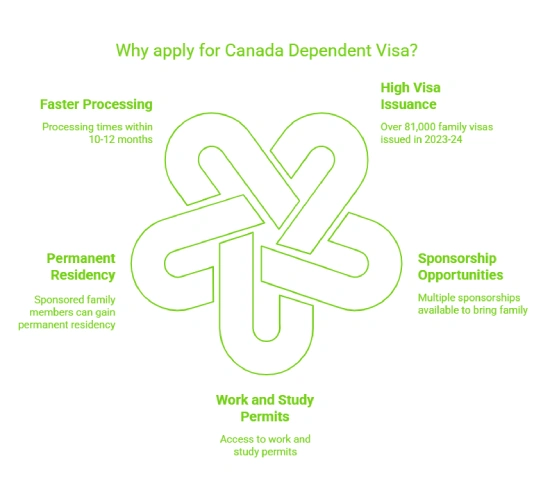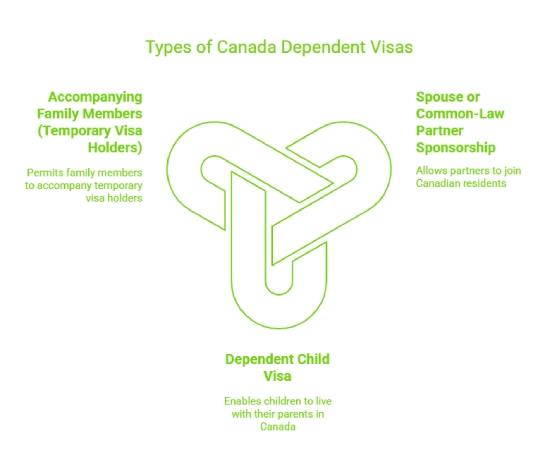Why apply for Canada Dependent Visa?
The Canada Dependent Visa facilitates family reunification by allowing eligible family members of Canadian citizens, permanent residents, or temporary residents to join them in Canada. This visa category encompasses various streams, each designed to cater to specific familial relationships.
- 81,000+ Family Visas Issued in 2023–24
- Apply Now for 2025 Canada Dependent Visa – Higher Quotas
- Multiple Sponsorship Options to Bring Your Family to Canada
- Access to Work and Study Permits for Sponsored Dependents
- Sponsored Family Members Can Directly Gain Permanent Residency
- Faster Processing Within 10–12 Months (IRCC Data)
- 2025 Immigration Target: 94,500 Family-Class PR Admissions
- PGP 2025 Intake Starts July 28 – 17,860 Invites to Be Sent
- Super Visa Option for Parents/Grandparents – 5-Year Stay Validity
- Canada Immigration 2025 Plan Prioritizes Family Reunification

What is a Canada Dependent Visa?
A Canada Dependent Visa is a family reunification pathway that allows eligible family members—such as spouses, common-law partners, and dependent children—of Canadian citizens, permanent residents, or valid temporary visa holders to live with them in Canada. It supports both temporary and permanent migration, depending on the sponsor’s status and the nature of the relationship.
There are several streams under this category:
- Spousal/Common-law Partner Sponsorship
- Dependent Child Sponsorship
- Accompanying Dependents of Students or Workers
Many dependents are eligible for open work permits or study permits, and sponsored family members can eventually become permanent residents. The program is a cornerstone of Canada’s immigration system, reflecting its commitment to keeping families together.
Types of Canada Dependent Visas
Canada offers several dependent visa categories to accommodate different family relationships:
Spouse or Common-Law Partner Sponsorship
Canadian citizens or permanent residents can sponsor their spouse or common-law partner to become permanent residents. The relationship must be genuine and not entered into solely for immigration purposes. Sponsored individuals may also be eligible for an open work permit while their application is processed.
Dependent Child Visa
This category allows Canadian citizens or permanent residents to sponsor their dependent children, including adopted children, to live with them in Canada. Children must be under 22 years of age and not have a spouse or common-law partner.
Accompanying Family Members (Temporary Visa Holders)
Temporary residents in Canada, such as those on work or study permits, can bring their immediate family members under this category. Dependents may be eligible for open work permits or study permits, depending on the primary applicant's status.

Eligibility for Canada Dependent Visa
To sponsor a dependent, the sponsor must:
- Age: Be at least 18 years old.
- Status: Be a Canadian citizen, permanent resident, or a temporary resident with the appropriate permits.
- Residency: Reside in Canada or plan to return to Canada when the sponsored person becomes a permanent resident.
- Financial Stability: Demonstrate the ability to provide basic needs for the dependent.
- Legal Obligations: Not be in prison, bankrupt, under a removal order, or charged with a serious offense.
Canada Dependent Visa Requirements from Australia
Applicants residing in Australia must provide:
- Valid Passport: For both sponsor and dependent.
- Proof of Relationship: Marriage certificate, birth certificate, or other relevant documents.
- Financial Documents: Evidence of the sponsor's ability to support the dependent.
- Medical Examination: Completed by an approved panel physician.
- Police Clearance: From countries where the dependent has lived for six months or more since the age of 18.
- Photographs: Meeting the specified requirements.

How to Apply for Canada Dependent Visa from Australia?
If you are residing in Australia and want to sponsor or apply as a dependent to join a family member in Canada, the following steps will guide you through the Canada Dependent Visa process:
Step 1: Determine Eligibility
Before applying, confirm that both the sponsor (in Canada) and the dependent (in Australia) meet the eligibility criteria.
Sponsors must be Canadian citizens or permanent residents aged 18 or older. The dependent must be a spouse, common-law partner, or child under 22 (or meet exceptional criteria if older). Temporary visa holders (students/workers) may also bring dependents under their own visa category.
Step 2: Gather Documentation
Collect all required documents to support your application, including:
- Valid passports for both sponsor and dependent
- Proof of relationship (e.g., marriage certificate, birth certificate)
- Proof of status in Canada (PR card, citizenship certificate, or study/work permit)
- Financial documents and police clearance if applicable
- Completed medical exams (if requested)
Step 3: Complete Application Forms
Go to the IRCC website and choose the appropriate sponsorship or dependent application package.
Forms may include:
- IMM 1344 (Sponsorship Application)
- IMM 0008 (Generic Application for Permanent Residence)
- IMM 5406 (Family Information Form), etc.
Step 4: Pay Application Fees
Pay your visa application fee online through the IRCC payment portal.
Fees depend on the stream:
- Spouse/partner sponsorship: CAD $1,080
- Dependent child: CAD $150 per child
- Biometrics: CAD $85 per person
Ensure to save the receipt and include it with your application package.
Step 5: Submit Application
- Upload or mail your completed application package as instructed.
- For online submissions (common for outside-Canada applications), use your IRCC Secure Account. Paper-based applications must be mailed to the processing center listed in the guide.
- Ensure all documents and fees are included to avoid delays.
Step 6: Await Processing & Updates
- Monitor your application status through your IRCC account.
- You may be asked to submit biometrics, attend a medical exam, or provide additional documents.
- Processing times vary, but most spousal sponsorships outside Canada take around 10–12 months. For dependents of temporary visa holders, timelines depend on the primary applicant's status.
Canada Dependent Visa Fees
The fees for dependent visa applications are as follows:
|
Visa Category |
Fee Type |
Amount (CAD) |
|
Spouse or Common-Law Partner |
Sponsorship Fee |
$85 |
|
Principal Applicant Processing Fee |
$545 |
|
|
Right of Permanent Residence Fee |
$575 |
|
|
Total |
$1,205 |
|
|
Dependent Child Sponsorship |
Sponsorship Fee |
$85 |
|
Processing Fee (per child) |
$85 |
|
|
Total (per child) |
$170 |
|
|
Biometrics |
Per Person |
$85 |
|
Family Maximum |
$170 |
Canada Dependent Visa Processing Time
Processing times vary based on the type of application and the applicant's country of residence. As of the latest updates:
- Spouse or Common-Law Partner Sponsorship (Outside Canada): Approximately 12 months.
- Dependent Child Sponsorship: Approximately 8 to 12 months.
- Accompanying Family Members (Temporary Visa Holders): Varies; typically processed within the same timeframe as the primary applicant's visa.
How Y-Axis Can Help You?
Navigating the Canada Dependent Visa process can be complex. Y-Axis offers comprehensive assistance to ensure a smooth application experience:
- Personalized Consultation: Assessing your eligibility and advising on the best visa pathway.
- Documentation Support: Guiding you in gathering and organizing necessary documents.
- Application Assistance: Helping you accurately complete and submit application forms.
- Follow-Up Services: Monitoring your application status and providing updates.
- Sign up with Y-Axis to know more about Dependent visa
Looking for Inspiration
Explore what Global Citizens have to say about Y-Axis in shaping their future
Frequently Asked Questions
